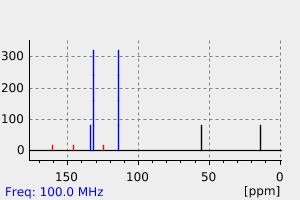1-methoxy-4-(2-nitro-1(Z)-propenyl)benzene | 207511-16-8
中文名称
——
中文别名
——
英文名称
1-methoxy-4-(2-nitro-1(Z)-propenyl)benzene
英文别名
1-(p-methoxyphenyl)-2-nitroprop-1-ene;4-Methoxy-β-nitro-propenyl-benzol;p-(2-Nitropropenyl)anisole;1-methoxy-4-[(Z)-2-nitroprop-1-enyl]benzene
CAS
207511-16-8
化学式
C10H11NO3
mdl
——
分子量
193.202
InChiKey
XQGFRDLMKKKSAH-FPLPWBNLSA-N
BEILSTEIN
——
EINECS
——
-
物化性质
-
计算性质
-
ADMET
-
安全信息
-
SDS
-
制备方法与用途
-
上下游信息
-
文献信息
-
表征谱图
-
同类化合物
-
相关功能分类
-
相关结构分类
物化性质
-
沸点:321.7±17.0 °C(Predicted)
-
密度:1.156±0.06 g/cm3(Predicted)
计算性质
-
辛醇/水分配系数(LogP):2.5
-
重原子数:14
-
可旋转键数:2
-
环数:1.0
-
sp3杂化的碳原子比例:0.2
-
拓扑面积:55
-
氢给体数:0
-
氢受体数:3
反应信息
-
作为反应物:描述:参考文献:名称:Fe-HCl:一种用于肟脱保护以及硝基烯烃和硝基烷烃选择性氧化水解为酮的有效试剂摘要:摘要 Fe-HCl 混合物被发现选择性地将硝基烯烃 1a-j 和硝基烷烃 2a-j 氧化水解为酮 3a-j。此外,观察到该试剂以优异的产率将肟 7a-j 脱保护为羰基化合物 8a-j。DOI:10.1081/scc-200051681
-
作为产物:参考文献:名称:芳基硝基烯烃作为巨噬细胞生成的氧化剂的清除剂摘要:氧和氮衍生的分子介导的氧化和硝化作用已涉及多种病理状况。相反,一氧化氮和过氧化氢是重要的信号传导中间体,其浓度受专门酶谱的严格控制,应通过添加外源抗氧化剂分子保持不受干扰,正如抗氧化剂维生素的干预研究已证明的那样。我们的目标是开发特定的抗氧化剂,以清除过氧亚硝酸盐阴离子以及其共轭酸,二氧化氮和羟基自由基的均相分解而产生的自由基。十四个取代的硝基烯烃,七个4-取代的1-(2-硝基-1Z-乙烯基)苯和七个4-取代的(2-硝基-1 Z合成和测试了具有不同立体化学和电子特性的-丙烯基苯。具有电子给体基团N,N-二甲基氨基的化合物显示出对过氧亚硝酸盐的最高反应速率,并且还与其均分解产物OH和NO 2反应。尽管1,1-二甲基氨基-4-(2-硝基-1 Z-乙烯基)苯作为未来发展的领先者而又没有干扰信号传导途径的风险,但由于它对过氧亚硝酸盐和过氧亚硝酸盐衍生的自由基具有高度特异性,因此其甲基化的类似物1,1-二甲基氨基-4-(2-硝基-1DOI:10.1016/j.ejmech.2013.12.029
文献信息
-
Conjugate Addition of Indoles to Nitroalkenes Promoted by Basic Alumina in Solventless Conditions作者:Roberto Ballini、Roberto Rabanedo Clemente、Alessandro Palmieri、Marino PetriniDOI:10.1002/adsc.200505339日期:2006.1alumina is found to promote the conjugate addition of indoles to nitroalkenes in solventless conditions at 60 °C. Nitroalkenes can be replaced by nitro alcohols that are converted into nitroolefins under the reaction conditions. Alternatively, a tandem nitroaldol-dehydration allows the utilization of nitroalkanes and aldehydes as remote precursors of reactive nitroalkenes in a ‘one–pot’ synthesis of 3-substituted
-
REDUCTIVE CONVERSION OF NITRO ALKENES TO KETONES AND/OR OXIMES IN AN AQUEOUS HClO<sub>4</sub>–CH<sub>2</sub>Cl<sub>2</sub>–DIOXANE–(Pb) SYSTEM作者:Sigeru Torii、Hideo Tanaka、Tetsuo KatohDOI:10.1246/cl.1983.607日期:1983.4.5Electrochemical and chemical reduction of nitro alkenes in an aqueous HClO4–CH2Cl2–dioxane–(Pb) system afforded ketones and oximes in good yields, each of which can be obtained selectively by treating with either aqueous formaldehyde or hydroxylamine as a proper workup process, respectively.
-
A Facile Procedure for the Conversion of Nitroolefins into Carbonyl Compounds Using Al-NiCl<sub>2</sub>·6H<sub>2</sub>O-THF System作者:Maitreyee S. Bezbarua、Ghanashyam Bez、Nabin C. BaruaDOI:10.1246/cl.1999.325日期:1999.4It has been demonstrated that a variety of nitroolefins can be efficiently converted into the corresponding carbonyl compounds by the reaction with an Al-NiCl2·6H2O-THF system.研究表明,多种硝基烯烃可通过与Al-NiCl2·6H2O-THF体系反应高效转化为相应的羰基化合物。
-
Inhibition of LDL oxidation and inflammasome assembly by nitroaliphatic derivatives. Potential use as anti-inflammatory and anti-atherogenic agents作者:Nicolás Cataldo、Bruno Musetti、Laura Celano、Claudio Carabio、Adriana Cassina、Hugo Cerecetto、Mercedes González、Leonor ThomsonDOI:10.1016/j.ejmech.2018.09.062日期:2018.11absence of the double bond next to the nitro group. The peroxyl radical scavenger capacity of the p-dimethylaminophenyl-derivatives was even higher, being the reduced form of these compounds even more active. In fact, while the antioxidant capacity of 1-dimethylamino-4-(2-nitro-1Z-ethenyl)benzene and 1-dimethylamino-4-(2-nitro-1Z-propenyl)benzene was 4.2 ± 0.1 and 5.4 ± 0.1 Trolox Eq/mol, respectively; ORAC先前我们已经显示了几种对位取代的芳基硝基烯烃的抗氧化和抗炎特性。由于氧化应激和炎症是驱动动脉粥样硬化发生和发展的关键过程,因此在本工作中,研究了芳基-硝基脂肪族衍生物(包括几种新设计的硝基烷烃)扩展文库的抗氧化,抗炎和抗动脉粥样硬化特性。 。使用氧自由基吸收能力测定(ORAC)测量的硝基脂肪族化合物的抗氧化能力表明,对-甲基硫代苯基衍生物在防止荧光素氧化方面比Trolox有效约三倍,而与硝基附近是否存在双键无关。对-二甲基氨基苯基衍生物的过氧自由基清除剂容量甚至更高,因为这些化合物的还原形式甚至更具活性。实际上,1-二甲氨基-4-(2-硝基-1Z-乙烯基)苯和1-二甲氨基-4-(2-硝基-1Z-丙烯基)苯的抗氧化能力为4.2±0.1和5.4±0.1 Trolox当量/摩尔;用乙基和丙基衍生物获得的ORAC值分别为10±1和13±2 Trolox Eq / mol。该P-二甲基氨基衍生物,尤
-
Attractive nonbonded interactions. The solution conformation of N-(1-phenyl-2-propyl)nicotinamide chloride作者:Farid M. El-Torki、John JacobusDOI:10.1021/jo00208a038日期:1985.4
表征谱图
-
氢谱1HNMR
-
质谱MS
-
碳谱13CNMR
-
红外IR
-
拉曼Raman
-
峰位数据
-
峰位匹配
-
表征信息
同类化合物
(R)-3-(叔丁基)-4-(2,6-二异丙氧基苯基)-2,3-二氢苯并[d][1,3]氧杂磷杂环戊烯
(2S,3R)-3-(叔丁基)-2-(二叔丁基膦基)-4-甲氧基-2,3-二氢苯并[d][1,3]氧杂磷杂戊环
(2S,2''S,3S,3''S)-3,3''-二叔丁基-4,4''-二甲氧基-2,2'',3,3''-四氢-2,2''-联苯并[d][1,3]氧杂磷杂戊环
(2R,2''R,3R,3''R)-3,3''-二叔丁基-4,4''-二甲氧基-2,2'',3,3''-四氢-2,2''-联苯并[d][1,3]氧杂磷杂戊环
(2-氟-3-异丙氧基苯基)三氟硼酸钾
(+)-6,6'-{[(1R,3R)-1,3-二甲基-1,3基]双(氧)}双[4,8-双(叔丁基)-2,10-二甲氧基-丙二醇
麦角甾烷-6-酮,2,3,22,23-四羟基-,(2a,3a,5a,22S,23S)-
鲁前列醇
顺式6-(对甲氧基苯基)-5-己烯酸
顺式-铂戊脒碘化物
顺式-四氢-2-苯氧基-N,N,N-三甲基-2H-吡喃-3-铵碘化物
顺式-4-甲氧基苯基1-丙烯基醚
顺式-2,4,5-三甲氧基-1-丙烯基苯
顺式-1,3-二甲基-4-苯基-2-氮杂环丁酮
非那西丁杂质7
非那西丁杂质3
非那西丁杂质22
非那西丁杂质18
非那卡因
非布司他杂质37
非布司他杂质30
非布丙醇
雷诺嗪
阿达洛尔
阿达洛尔
阿莫噁酮
阿莫兰特
阿维西利
阿索卡诺
阿米维林
阿立酮
阿曲汀中间体3
阿普洛尔
阿普斯特杂质67
阿普斯特中间体
阿普斯特中间体
阿托西汀EP杂质A
阿托莫西汀杂质24
阿托莫西汀杂质10
阿托莫西汀EP杂质C
阿尼扎芬
阿利克仑中间体3
间苯胺氢氟乙酰氯
间苯二酚二缩水甘油醚
间苯二酚二异丙醇醚
间苯二酚二(2-羟乙基)醚
间苄氧基苯乙醇
间甲苯氧基乙酸肼
间甲苯氧基乙腈
间甲苯异氰酸酯







